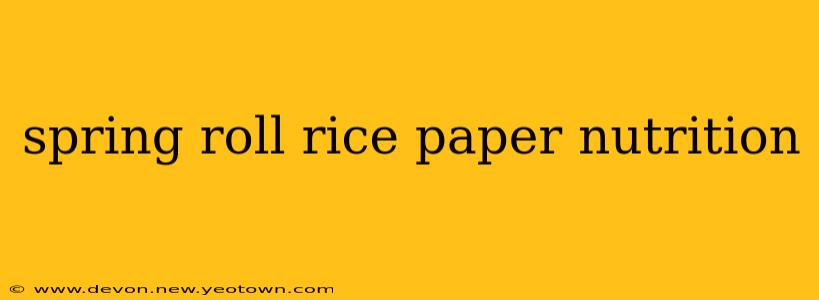Spring rolls are a delightful and refreshing dish, often enjoyed as a light meal or appetizer. The star of the show, especially in the realm of health-conscious eating, is the rice paper wrapper itself. But what exactly is in this seemingly simple ingredient, and how does its nutritional profile stack up? Let's unravel the nutritional secrets of spring roll rice paper.
What are Spring Roll Rice Papers Made Of?
Spring roll rice paper, at its core, is made from just one ingredient: rice flour. This makes it naturally gluten-free, a significant advantage for those with celiac disease or gluten sensitivities. The process involves mixing water with rice flour to create a thin, almost translucent sheet, which is then dried. Different brands may vary slightly in their processing, but the basic composition remains the same. Some might add a tiny amount of tapioca starch for added strength or texture, but this is generally minimal.
Are Spring Roll Rice Papers Healthy?
The short answer is: yes, generally. Because they're primarily rice flour, they're a relatively low-calorie option compared to other wraps like tortillas or flatbreads. They offer a good source of carbohydrates, providing energy. However, the nutritional content is fairly minimal compared to other food groups.
How Many Calories are in a Spring Roll Rice Paper?
The calorie count per sheet varies slightly depending on the brand and size, but generally, a single spring roll rice paper contains around 30-40 calories. This low calorie count makes it an excellent choice for those watching their weight.
How much fiber is in spring roll rice paper?
While spring roll rice paper is low in calories, it's not a significant source of fiber. The fiber content is generally quite low, contributing minimally to your daily fiber intake. The nutritional value primarily comes from the fillings you add.
Does spring roll rice paper contain any vitamins or minerals?
Spring roll rice paper itself is not a significant source of vitamins or minerals. Its nutritional value comes mainly from being a low-calorie, gluten-free alternative to other wraps. The vitamins and minerals in your spring roll will predominantly come from the filling ingredients, such as vegetables, herbs, and protein sources.
Is spring roll rice paper a good source of protein?
No, spring roll rice paper is not a significant source of protein. Protein is largely absent in rice paper; the protein content in your spring roll will come entirely from the fillings, such as tofu, shrimp, or chicken.
Are there any downsides to eating spring roll rice paper?
While generally healthy, there are a few considerations:
- Glycemic Index: Rice paper has a relatively high glycemic index (GI), meaning it can cause a rapid spike in blood sugar levels. This is important to consider for individuals with diabetes or those managing their blood sugar.
- Nutrient Density: As previously mentioned, rice paper is low in micronutrients and fiber. Therefore, it’s crucial to focus on nutrient-rich fillings to make your spring rolls a truly balanced and healthy meal.
Ultimately, spring roll rice paper provides a versatile, gluten-free, and low-calorie base for a nutritious and delicious meal. By focusing on vibrant fillings packed with vegetables, lean proteins, and healthy fats, you can create a spring roll that is both satisfying and supports a healthy lifestyle. Remember, the nutritional value of your spring roll depends heavily on the ingredients you choose for the filling!

